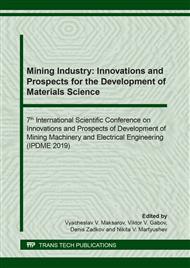[1]
A.S. Orlin et al., Internal combustion engines: The arrangement and operation of piston and combined engines, Mashinostroenie Publ., Moscow, 1990, 289 p.
Google Scholar
[2]
I.A. Mishin, Durability of engines, Mashinostroenie Publ., Leningrad, 1976, 288 p.
Google Scholar
[3]
A.S. Orlin, Calculation of working processes in internal combustion engines, Mashinostroenie Publ., Moscow, 2008, 157 p.
Google Scholar
[4]
A.P. Minakov, M.E. Lustenkov, E.V. Ilyushina, Herald of mechanical engineering 2 (2016) 16–21.
Google Scholar
[5]
A.G. Grigoryants, I.N. Shiganov, A.I. Misyurov, Technological procedures of laser processing, Bauman MGTU, 2006, 246 p.
Google Scholar
[6]
V.G. Kovalenko, A.D. Verkhoturov, L.F. Golovko et al., Laser and electroerosive hardening of materials, Nauka Publ., Moscow, 1986, 276 p.
Google Scholar
[7]
N.N. Rykalin, A.A. Uglov, A.N. Kokora, Laser processing of materials, Mashinostroenie Publ., Мoscow, 1975, 295 p.
Google Scholar
[8]
V.I. Shastin, A.N. Malov, Fundamental Problems of Opto- and Microelectronics, Khabarovsk, 2004, p.263–267.
Google Scholar
[9]
S.V. Kostromin, Collected scientific papers of SWorld based on materials of the international Research-to-Practice Conf., vol. 6, no. 1, p.37–40, (2008).
Google Scholar
[10]
V.E. Borozinets, S.V. Kostromin, Modern innovations in science and technology, Mater. of the 3rd Int. scientificand practical conf., p.28–31, 2013, Kursk.
Google Scholar
[11]
A.E. Balanovsky, V.V. Kondratev, M.G. Shtayger et al., IOP Conf. Ser. Mater. Sci. and Engineer. 411 (2018) 012014.
Google Scholar
[12]
A.E. Balanovsky, M.G. Shtaiger, M.V. Grechneva et al., IOP Conf. Ser. Mater. Sci. and Engineer. 411(2018) 012012.
Google Scholar
[13]
N.N. Ivanchik, A.E. Balanovsky, M.G. Shtayger et al., IOP Conf. Ser. Mater. Sci. and Engineer. 411 (2018) 012035.
Google Scholar
[14]
A.E. Balanovsky, M.G. Shtayger, V.V. Kondratev et al., IOP Conf. Ser. Mater. Sci. and Engineer. 411 (2018) 012013.
Google Scholar
[15]
A.E. Balanovsky, M.G. Shtaiger, V.V. Kondratev et al., J. of phys.: conf. ser. (2018) 012006.
Google Scholar
[16]
A.G. Suslov, The quality of the surface layer of machine parts, Mashinostroenie Publ., Moscow, 2000, 320 p.
Google Scholar
[17]
I.V. Kragelsky, Friction and wear, Mashinostroenie Publ., Moscow, 1968, 480 p.
Google Scholar
[18]
V.K. Pogodin, V.E. Gozbenko, IOP Conf. Ser. Mater. Sci. and Engineer. (2019) 012150.
Google Scholar
[19]
V.Yu. Konyuhov, A.M. Gladkih, A.V. Chemezov, IOP Conf. Ser. Mater. Sci. and Engineer. (2019) 012147.
Google Scholar
[20]
A.E. Balanovskiy, M.G. Shtayger, A.I. Karlina et al., IOP Conf. Ser. Mater. Sci. and Engineer. (2019) 012138.
Google Scholar
[21]
E.A. Guseva, S.K. Kargapoltsev, A.E. Balanovskiy et al., IOP Conf. Ser. Mater. Sci. and Engineer. (2019) 012181.
Google Scholar
[22]
K.N. Vdovin, D.A. Gorlenko, N.A. Feoktistov, Steel in Translation 46(7) (2016) 484–488.
Google Scholar
[23]
K.N. Vdovin, N.V. Koptseva, D.S. Gorlenko et al., Steel in Translation 49(4) (2019) 281–285.
Google Scholar
[24]
K.N. Vdovin, V.V. Tochilkin, V.V. Tochilkin, Refractories and Industrial Ceramics 57(3) (2016) 221–223.
DOI: 10.1007/s11148-016-9956-z
Google Scholar
[25]
K.N. Vdovin, N.A. Feoktistov, E.V. Sinitskii et al., Steel in Translation 45(10) (2015) 729–732.
Google Scholar
[26]
V.N. Letimin, K.N. Vdovin, V.G. Druzhkov et al., CIS Iron and Steel Review 2014(9) (2014) 54–56.
Google Scholar
[27]
A.G. Suslov, A.M. Dalsky, Scientific foundations of engineering technology, Mashinostroenie Publ., Moscow, 2002, 684 p.
Google Scholar


